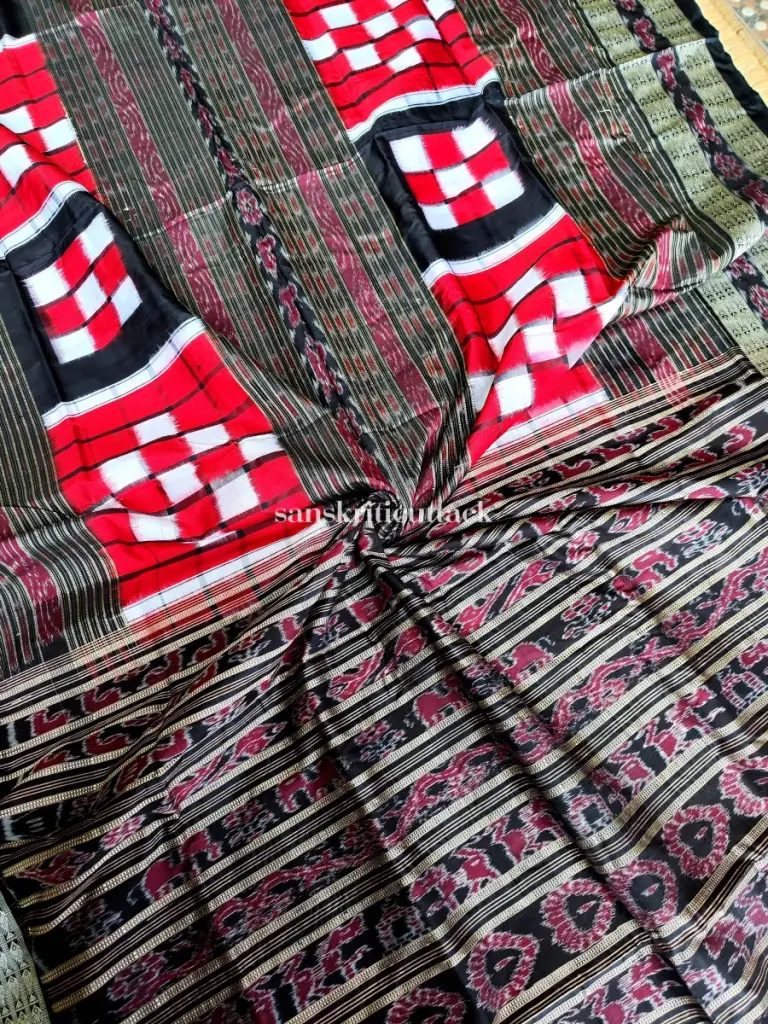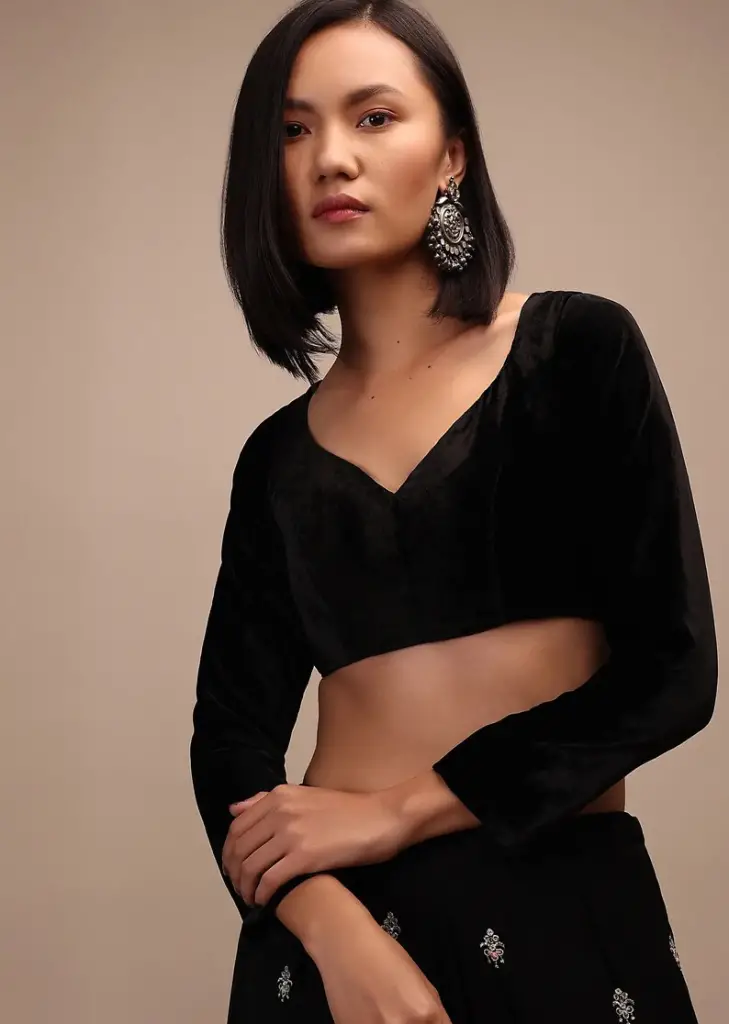Bomkai Silk saree, also known as Sonepuri silk saree, is an exquisite example of the traditional handloom weaves of Odisha, a state located in eastern India.
These sarees are famous for their intricate designs, vibrant colors, and lustrous texture. Bomkai Silk sarees are named after the Bomkai village in the Ganjam district of Odisha where they originated.
Bomkai Silk sarees are handwoven using a traditional technique that involves interlacing warp and weft threads to create intricate designs on the fabric.
The sarees are made using pure silk or silk-cotton blends, which give them a soft and smooth texture.
HISTORY OF BOMKAI SILK SAREE
Bomkai Silk saree has a rich history that dates back to ancient times.
The art of weaving Bomkai Silk sarees has been passed down through generations of weavers in the region, making it an important part of the cultural heritage of Odisha.
The weavers in the village were inspired by the traditional motifs and designs of the neighboring regions and started incorporating them into their sarees.
The origin of Bomkai Silk sarees can be traced back to the 8th century when the region of Odisha was ruled by the Bhaumakara dynasty.
During this time, silk weaving became a popular profession, and weavers started producing silk sarees with intricate designs and patterns.
The sarees were originally made using pure silk threads that were dyed with natural colors extracted from plants and flowers.
Over time, Bomkai Silk sarees became more popular, and weavers began experimenting with different designs and patterns.
The sarees are known for their unique weaving style that combines both the ikat and the embroidery techniques.
The weaving process involves tying the threads before dyeing them, which results in a distinctive pattern that adds to the beauty of the saree.
In the past, Bomkai Silk sarees were only worn by women from the upper castes in society. However, with time, these sarees became more popular among women from all walks of life.
THE HANDS BEHIND THE CRAFT
The leading craftsmen of the bomkai silk saree is the “Bhulia” community of Subarnapur. The craftsmanship’s intensity is transparent in the structured and intricate work.
A single marvelous piece of work requires four to five pairs of hands and almost 35 days. Motifs like tribal art, tortoise, flies, lotus, bird, flowers and mythological characters like Rudarksh , Kumbha, Indra are put to adorn the elegance.
WEAVING OF BOMKAI SILK SAREE
The production process of Bomkai Silk sarees involves several steps, from the procurement of raw materials to the final finishing of the saree.
![Weaving of Bomkai Silk Saree [infographic]](https://colorsaree.com/wp-content/uploads/2023/04/Weaving-of-Bomkai-Silk-Saree-infographic-1024x983.jpg)
- Procurement of Raw Materials: The first step in the production process of Bomkai Silk sarees is the procurement of raw materials. The weavers use pure silk yarns and cotton threads to create the saree. The silk yarns are procured from silk farms in different parts of the country.
- Dyeing of Silk Yarn: Silk yarns are dyed using natural dyes extracted from plants and flowers. The weavers use different combinations of dyes to create a range of colors.
- Designing and Drafting: Once the silk yarns are dyed, the weavers create a design for the saree. The design is first drawn on paper and then transferred onto the graph paper. The weavers use graph paper to draft the design of the saree.
- Preparing the Warp and Weft: The next step is preparing the warp and weft. The warp is the lengthwise set of threads that runs through the saree, and the weft is the crosswise set of threads that runs across the saree. The warp threads are tied to the loom, while the weft threads are interlaced with the warp threads to create the pattern.
- Tying and Dyeing of Threads: The weavers use a variety of techniques such as ikat, jacquard, and dobby to create different designs on the saree. The ikat technique involves dyeing the threads before weaving, which gives the saree a blurred effect. The tied threads are then dipped into the dye to create the desired pattern. The jacquard technique involves creating intricate designs using punched cards, while the dobby technique involves creating small, geometric patterns.
- Weaving the Saree: Once the threads are dyed, the weaving of the saree begins. The weavers use a traditional handloom to weave the saree. They use a shuttle to pass the weft threads through the warp threads to create the fabric.
- Embroidery and Finishing: After the weaving process is complete, the saree is given a final finishing touch. The saree is washed to remove any impurities and then starched to give it a stiff texture. The saree is then embroidered with intricate designs using a needle and thread.
- Quality Check: Before the saree is ready for sale, it goes through a quality check to ensure that it meets the desired standards of the weavers. Any defects are corrected before the saree is finally packaged and sent for sale.
WHAT IS THE SPECIALITY OF BOMKAI SAREE?
Bomkai dares to be unique compared to the majority of conventional designs painted on the surface of different fabrics. The patterns and designs depict mythology and long-lost secrets.
Southern India’s textile industry is centred in Bomkai, which draws its inspiration from the folklore of Orissan culture.
Bomkai does not, however, disregard the free inspiration that nature provides to everyone.
Designs composed of the most bizarre ideas combine motifs from the environment, such as the atasi flower, the kanthi phul (small flower), fly, rui macchi (carp-fish),padma (lotus), koincha (tortoise), and mayura (peacock),
The borders and pallavs contribute significantly to the finishing of Bomkai silk sarees. Some of the sarees feature tribal art-inspired border patterns. Mitkta Panjia, Kumbha, Rudraksha, and Floral are examples.
In contrast, colours are motivated by the impact of contrast. With a yellow saree, the border may be a nice, bright green, and with an orange saree, it may be an equally captivating and mesmerising black.
Occasionally, the pallav may be double-toned, reflecting a royal radiance. In addition, the border of a Bomkai saree is frequently adorned with diamond-shaped latticework.
DIFFERENT TYPES OF BOMKAI SILK SAREES
Sonepuri Saree
Sonepuri Saree is one of the most popular varieties of Bomkai Silk sarees. It is named after the town of Sonepur in Odisha, where it is traditionally woven.

Pasapalli Saree
Pasapalli Saree is another popular variety of Bomkai Silk saree. In this saree, there will be small check designs all throughout the saree which are created using the ikat technique. The saree is typically woven in black and white, with a red border.

Barpali Saree
Barpali Saree is woven in the town of Barpali in Odisha.”Pali” is synonymous with “rural community.” On the saree will be depictions of Palli-chitra (pastoral life). The saree is typically woven in earthy colors, such as brown, beige, and green.

Bapta Saree
Bapta Saree is woven in the town of Bapta in Odisha. The saree is typically embellished with zari work and embroidered with traditional motifs.

MAINTENANCE AND CARE OF BOMKAI SILK SAREE
Bomkai Silk sarees require special care and attention to maintain their luster and texture. Bomkai Silk sarees should be dry-cleaned to avoid damage to the fabric.
It is not to be washed at home as it can ruin the texture and design of the saree. It is suggested to store the saree in a cool and dry place and avoid storing it in direct sunlight or damp areas as it can cause the fabric to fade or become discolored.
Bomkai silk saree should be ironed at a low temperature to avoid damage to the fabric while using a cotton cloth over the saree while ironing to protect it from direct heat.
In case of stains, the saree should be taken to a professional cleaner immediately. One should not attempt to remove the stain at home as it can damage the fabric.
OCCASION PREFERENCE FOR SILK BOMKAI SAREE
Bomkai Silk sarees are a popular choice for traditional occasions and ceremonies in Odisha. They are often worn by women during weddings, festivals, and other religious ceremonies.
The sarees are also popular among women who prefer traditional wear for formal occasions such as office parties and functions.
HOW TO IDENTIFY AUTHENTIC BOMKAI SILK SAREE
- These are traditionally distinguished by their use of heavily stylized floral and geometric patterns in the borders, and border of contrasting colour.
- In general, colours are extremely vibrant, such as red, black, dark green, dark blue, and white.
- Uncommon amongst other fabrics, these patterns feature little dots.
- The body and pallu warps are joined to create a colour contrast effect. Occasionally, it combines tie-dye with supplementary designs.
BOMKAI SILK SAREE BLOUSE DESIGNS
- Elbow-Length Sleeves

- Boat Neck Blouse

- High Neck Blouse

- Backless Blouse

Bomkai Silk Saree Price BOMKAI SILK SAREE PRICE
A good quality Bomkai silk saree can range anywhere from INR 3000 to INR 15,000 or more. Some high-end designer Bomkai silk sarees with intricate designs and motifs can cost even more.
The price range of Bomkai silk sarees in India can vary depending on several factors such as the quality of silk, the intricacy of the design and the workmanship involved in the weaving process.
In some places, like Odisha, the sarees may be available at a slightly lower price compared to other regions.
STORES FOR BUYING BOMKAI SILK SAREE ONLINE
- Amazon
- Nykaa Fashion
- Etsy
- Craft collection
- Priyadarshanini
- Classystreet
- Sanskriti Vintage
- Indian Villez
- Gocoop
- Adi Mohani Mohan Kanjilal
- Indian Silk House
- Utalika Odisha
- Poshmark
- Mirraw
- Silken Thread
- Indian SIlk house agencies
- Bigrayn
- Craftyle
- Charukriti
- Sankriti Cuttack
- Utkalamrita
LATEST BOMKAI SILK SAREE TRENDS
Bomkai silk sarees have been popular in India for many years and continue to be in demand among women of all ages and backgrounds.
The intricate designs and motifs of Bomkai silk sarees, coupled with the high-quality silk used in their production, make them timeless garment that is prized for their elegance and sophistication.
In recent years, the popularity of Bomkai silk sarees has spread beyond Odisha to other parts of India and the world.
Many weavers and designers have started using natural dyes and organic materials in the production process, which has further increased the popularity of these sarees.
In addition, many celebrities and fashion icons have been spotted wearing Bomkai silk sarees, further adding to their popularity and demand.
The growing popularity of Bomkai silk sarees has also been fueled by the availability of these sarees on e-commerce platforms and online marketplaces.
Customers can now purchase Bomkai silk sarees from anywhere in the world, making them more accessible to a wider audience.
With efforts to promote the art of handloom weaving and support the weavers, Bomkai Silk sarees are expected to continue to be an important part of the cultural landscape of Odisha for years to come.







